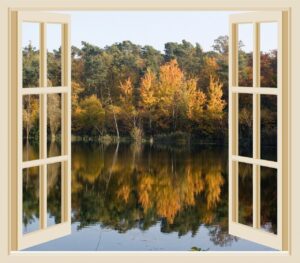
As winter draws in…
Although you may feel like closing the curtains tight and shutting all windows to keep the cold air out, this practice could be harming your home – and yourself. It’s only natural as the air outside gets colder, to want to cosy-up indoors – but in doing so, we are also in danger of blocking out the fresh air that we need so much.
With sustainable living, we often focus on energy-efficient appliances, renewable energy sources, and eco-friendly materials. However, one crucial aspect that is sometimes overlooked is home ventilation.
The air we breathe within our homes significantly impacts both our health and the environment. In this blog we explore the often-underestimated link between home ventilation and sustainable living, and look at how the air we circulate within our living spaces can contribute to a healthier, more eco-conscious lifestyle.
It is evident that the air we breathe within our homes is as critical as the materials we choose or the energy sources we use. Sustainable, secure ventilation isn't just a technological advancement; it's a holistic approach to creating living spaces that prioritise health, comfort and environmental responsibility. By embracing innovative ventilation solutions and advocating for sustainable practices, we can breathe new life into our homes and contribute to a greener, healthier future.
How our health is impacted
One of the first tell-tale signs of poor ventilation is a sore throat or irritation of the nose and eyes. Airborne dust and particles stick to your hands and when you rub your nose, eyes, or mouth they can cause irritation.
If poor ventilation continues to be a problem, you might experience headaches, fatigue and shortness of breath. Dizziness is a common symptom, too. All of these symptoms are magnified in sensitive groups who have respiratory diseases or asthma. (Higher concentrations of contaminants and dust will force your lungs to work harder and this can overwhelm people with asthma and lead to more asthma attacks.)
Feeling ‘blue’ and sleeping less?
Do you find that you sleep less well in the colder months? Is your mood affected by SAD (Seasonal Affective Disorder)? Studies have shown that poor sleep is linked to poor ventilation. And… as fresh air is saturated with oxygen, the more oxygen you breathe, the higher your serotonin levels. Serotonin is a hormone that improves your mood and, without it, you won’t feel as happy. With poor ventilation, the air is not as saturated with oxygen, which will make you feel sadder and less energetic. It’s thought the ‘winter blues’ (SAD), affects around 2 million people in the UK and more than 12 million people across northern Europe. It can affect people of any age, including children.
The silent influence of indoor air quality
Indoor air quality plays a pivotal role in our well-being, and it's intimately connected to how we design and ventilate our homes. Poor ventilation can lead to the accumulation of pollutants, such as volatile organic compounds (VOCs), mould and allergens, which can have detrimental effects on respiratory health. Sustainable living extends beyond reducing our carbon footprint; it involves creating living spaces that prioritise both the health of occupants and the environment.
Energy-efficient ventilation systems
- Reduced Heating and Cooling Loads - proper ventilation helps to regulate indoor temperature by allowing the escape of hot air in warmer months and preventing heat loss during colder months. This reduces the reliance on heating and cooling systems, resulting in significant energy savings.
- Improved HVAC System Efficiency - well-ventilated homes put less strain on heating, ventilation, and air conditioning (HVAC) systems. When poor ventilation causes excess moisture and pollutants to accumulate, HVAC systems have to work harder to maintain indoor air quality. With proper ventilation, the load on these systems is reduced, thereby improving their efficiency and lifespan.
- Avoidance of condensation and mould - insufficient ventilation can lead to condensation on windows, walls, and other surfaces, promoting the growth of mould and mildew. Mould not only damages the building materials but also compromises indoor air quality. By ensuring adequate ventilation, you can prevent condensation and mould problems, prevent costly repairs and the need for mould remediation.
Natural ventilation as a sustainable design principle
Harnessing the power of nature is a cornerstone of sustainable living. Natural ventilation, a design strategy that incorporates the natural movement of air, is a cost-effective and energy-efficient solution. Well-placed windows, skylights and vents can facilitate the circulation of fresh air, reducing the need for mechanical ventilation systems. This not only decreases energy consumption but also connects occupants with their surroundings, fostering a sense of harmony with nature.
Sustainable living involves not just the initial design but the ongoing maintenance of our living spaces. Regular maintenance of ventilation systems ensures their optimal performance, preventing energy waste and potential health hazards. Choosing eco-friendly cleaning products and filters, and ensuring proper insulation, are additional sustainable practices tied to home ventilation.
The role of ventilation in moisture control
Effective moisture control is integral to sustainable living. Poorly ventilated homes are prone to dampness and mould growth, which not only jeopardises the structural integrity of the building, but also poses health risks. Sustainable ventilation strategies, such as exhaust fans in kitchens and bathrooms, contribute to moisture control. By preventing excessive humidity, these systems enhance the durability of the building and create healthier living conditions.
The impact of ventilation on building materials
The materials used in constructing our homes are a significant factor in their overall sustainability. Proper ventilation can extend the lifespan of these materials by preventing issues such as rot and decay. By reducing the likelihood of structural damage, effective ventilation supports a more sustainable approach to home construction, minimising the need for frequent renovations and material replacements.
Integrating smart technologies for sustainable ventilation
In the era of smart homes, integrating technology into ventilation systems enhances sustainability. Smart ventilation systems can adjust airflow based on occupancy and air quality, optimising energy use. Additionally, these systems can be remotely monitored and controlled, allowing occupants to make real-time adjustments for improved efficiency and comfort.
It’s not only homes that benefit from smart technology when it comes to ventilation. Smart work places can control and regulate a variety of building management functions automatically. They do so by employing a network of Internet of Things (IoT) devices such as sensors, thermostats, locks and more, all of which detect everything from sound and vibration to heat, movement and light levels.
The information drawn through the IoT devices is channelled into a smart building analytics platform, where facilities management staff are able to access a detailed data view. This data can then be used to make educated decisions and take well-informed actions.
The next time you find yourself closing the windows earlier than normal during the autumn and winter months – spare a thought for your home’s air quality. If there is no natural air coming into your home – you are restricting a priceless natural resource: your breath of fresh air!
Carl Dodd, Property Revolutions Ltd.

